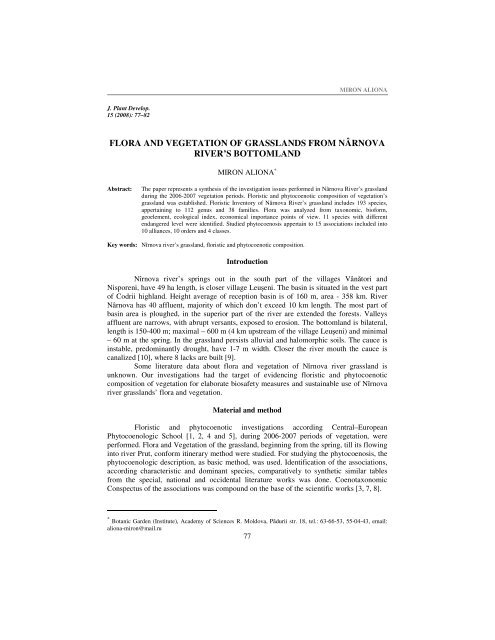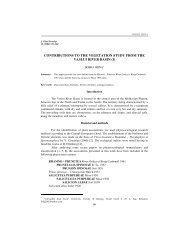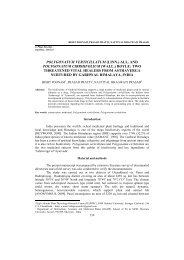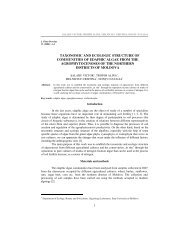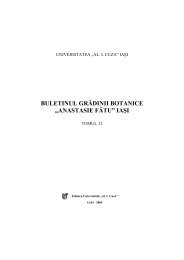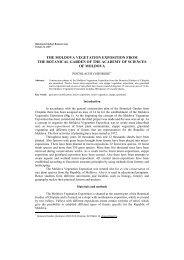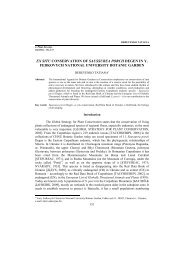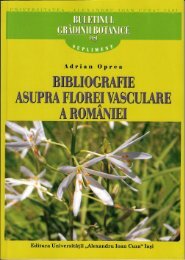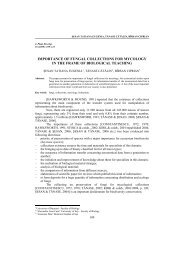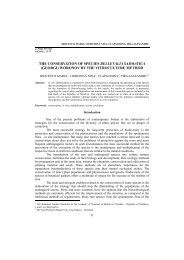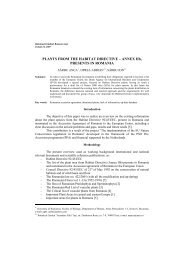flora and vegetation of grasslands from nârnova river's bottomland
flora and vegetation of grasslands from nârnova river's bottomland
flora and vegetation of grasslands from nârnova river's bottomland
Create successful ePaper yourself
Turn your PDF publications into a flip-book with our unique Google optimized e-Paper software.
MIRON ALIONA<br />
J. Plant Develop.<br />
15 (2008): 77–82<br />
FLORA AND VEGETATION OF GRASSLANDS FROM NÂRNOVA<br />
RIVER’S BOTTOMLAND<br />
MIRON ALIONA ∗<br />
Abstract:<br />
The paper represents a synthesis <strong>of</strong> the investigation issues performed in Nârnova River’s grassl<strong>and</strong><br />
during the 2006-2007 <strong>vegetation</strong> periods. Floristic <strong>and</strong> phytocoenotic composition <strong>of</strong> <strong>vegetation</strong>’s<br />
grassl<strong>and</strong> was established. Floristic Inventory <strong>of</strong> Nârnova River’s grassl<strong>and</strong> includes 193 species,<br />
appertaining to 112 genus <strong>and</strong> 38 families. Flora was analyzed <strong>from</strong> taxonomic, bi<strong>of</strong>orm,<br />
geoelement, ecological index, economical importance points <strong>of</strong> view. 11 species with different<br />
endangered level were identified. Studied phytocoenosis appertain to 15 associations included into<br />
10 alliances, 10 orders <strong>and</strong> 4 classes.<br />
Key words: Nîrnova river’s grassl<strong>and</strong>, floristic <strong>and</strong> phytocoenotic composition.<br />
Introduction<br />
Nîrnova river’s springs out in the south part <strong>of</strong> the villages Vântori <strong>and</strong><br />
Nisporeni, have 49 ha length, is closer village Leueni. The basin is situated in the vest part<br />
<strong>of</strong> Codrii highl<strong>and</strong>. Height average <strong>of</strong> reception basin is <strong>of</strong> 160 m, area - 358 km. River<br />
Nârnova has 40 affluent, majority <strong>of</strong> which don’t exceed 10 km length. The most part <strong>of</strong><br />
basin area is ploughed, in the superior part <strong>of</strong> the river are extended the forests. Valleys<br />
affluent are narrows, with abrupt versants, exposed to erosion. The bottoml<strong>and</strong> is bilateral,<br />
length is 150-400 m; maximal – 600 m (4 km upstream <strong>of</strong> the village Leueni) <strong>and</strong> minimal<br />
– 60 m at the spring. In the grassl<strong>and</strong> persists alluvial <strong>and</strong> halomorphic soils. The cauce is<br />
instable, predominantly drought, have 1-7 m width. Closer the river mouth the cauce is<br />
canalized [10], where 8 lacks are built [9].<br />
Some literature data about <strong>flora</strong> <strong>and</strong> <strong>vegetation</strong> <strong>of</strong> Nîrnova river grassl<strong>and</strong> is<br />
unknown. Our investigations had the target <strong>of</strong> evidencing floristic <strong>and</strong> phytocoenotic<br />
composition <strong>of</strong> <strong>vegetation</strong> for elaborate biosafety measures <strong>and</strong> sustainable use <strong>of</strong> Nîrnova<br />
river grassl<strong>and</strong>s’ <strong>flora</strong> <strong>and</strong> <strong>vegetation</strong>.<br />
Material <strong>and</strong> method<br />
Floristic <strong>and</strong> phytocoenotic investigations according Central–European<br />
Phytocoenologic School [1, 2, 4 <strong>and</strong> 5], during 2006-2007 periods <strong>of</strong> <strong>vegetation</strong>, were<br />
performed. Flora <strong>and</strong> Vegetation <strong>of</strong> the grassl<strong>and</strong>, beginning <strong>from</strong> the spring, till its flowing<br />
into river Prut, conform itinerary method were studied. For studying the phytocoenosis, the<br />
phytocoenologic description, as basic method, was used. Identification <strong>of</strong> the associations,<br />
according characteristic <strong>and</strong> dominant species, comparatively to synthetic similar tables<br />
<strong>from</strong> the special, national <strong>and</strong> occidental literature works was done. Coenotaxonomic<br />
Conspectus <strong>of</strong> the associations was compound on the base <strong>of</strong> the scientific works [3, 7, 8].<br />
∗ Botanic Garden (Institute), Academy <strong>of</strong> Sciences R. Moldova, Pdurii str. 18, tel.: 63-66-53, 55-04-43, email:<br />
aliona-miron@mail.ru<br />
77
FLORA AND VEGETATION OF GRASSLANDS FROM NÎRNOVA RIVER’S BOTTOMLAND<br />
A. Floristic diversity<br />
Results <strong>and</strong> discussions<br />
Taxonomic analysis<br />
In the grassl<strong>and</strong> spontaneous <strong>flora</strong> 193 species, appertaining to 112 genus <strong>and</strong> 38<br />
families were evidenced. Taxonomic analysis the number <strong>of</strong> species <strong>of</strong> families was<br />
established: Asteraceae (30 sp.-15,5%), Poaceae (23 sp.-11,9%), Fabaceae (17 sp.-8,8%),<br />
Cyperaceae (15 sp.-7,7%), Brassicaceae <strong>and</strong> Polygonaceae (11 sp.-5,7% each). 6 fam.<br />
includes 107 sp. (55,4%) <strong>of</strong> vascular plant, others 32 fam. summarize 44,6%.<br />
The most representative genuses are Carex (11 sp.-5,7%), Rumex (7 sp.-3,6%),<br />
Plantago (6 sp.-3,1%), Juncus, Trifolium, Polygonum (4 sp. each). The List <strong>of</strong> the vascular<br />
plant species evidenced in grassl<strong>and</strong> <strong>flora</strong>’s is presented: Achillea collina, A. nobilis, A.<br />
setacea, Agrostis stolonifera, A. tenuis, Alisma lanceolatum, A. plantago-aquatica, Allium<br />
rotundum, Alopecurus arundinaceus, A. pratensis, Althaea <strong>of</strong>ficinalis, Ambrosia<br />
artemisiifolia, Anchusa gmelinii, Arctium minus, Arrhenatherum elatius, Artemisia<br />
absinthium, A. austriaca, A. vulgaris, Atriplex littoralis, A. micrantha, A. nitens, Bassia<br />
sedoides, Batrachium rionii, Beckmannia eruciformis, Berteroa incana, Bolboschoenus<br />
maritimus, Borago <strong>of</strong>ficinalis, Bromus arvensis, B. japonicus, B. squarrosus, Bryonia alba,<br />
Butomus umbellatus, Capsella bursa-pastoris, Caragana scythica, Cardaria draba, Carex<br />
acutiformis, C. distans, C. extensa, C. hirta, C. hordeistichos, C. melanostachya, C.<br />
muricata, C. otrubae, C. riparia, C. secalina, C. vulpina, Cerastium perfoliatum,<br />
Ceratophyllum demersum, C. submersum, Chenopodium album, C. glaucum, Cichorium<br />
intybus, Cirsium arvense, Conium maculatum, Consolida regalis, Convolvulus arvensis,<br />
Cynodon dactylon, Cynoglossum <strong>of</strong>ficinale, Daucus carota, Descurainia sophia, Echinops<br />
ritro, Elaeagnus angustifolia, Eleocharis palustris, Elytrigia intermedia, E. repens,<br />
Equisetum arvense, E. telmateia, Erigeron acris, Festuca arundinacea, F. pratensis,<br />
Fragaria vesca, Frankenia pulverulenta, Galega <strong>of</strong>ficinalis, Galium aparine, G. mollugo,<br />
G. verum, Geranium collinum, Glyceria fluitans, G. nemoralis, Hieracium caespitosum,<br />
Inula germanica, Iris germanica, I. halophila, I. pseudacorus, Juncus bufonius, J.<br />
compressus, J. gerardii, J. inflexus, Lactuca quercina, Lathyrus tuberosus, Lemna minor,<br />
Leonurus quinquelobatus, Lepidium latifolium, L. ruderale, Leucanthemum vulgare,<br />
Linaria ruthenica, Lolium perenne, Lotus corniculatus, L. tenuis, Lycopus europaeus, L.<br />
exaltatus, Lysimachia nummularia, Lythrum salicaria, L. virgatum, Malva neglecta,<br />
Matricaria perforata, M. recutita, Medicago falcata, M. lupulina, M. sativa, Melampyrum<br />
arvense, Melilotus alba, M. <strong>of</strong>ficinalis, Mentha arvensis, Myosotis arvensis, Papaver<br />
rhoeas, Phragmites australis, Picris hieracioides, Plantago cornuti, P. lanceolata, P.<br />
major, P. maritima, P. media, P. urvillei, Poa angustifolia, P. pratensis, Polygonum<br />
amphibium, P. aviculare, P. lapathifolium, P. scabrum, Potentilla argentea, P. recta, P.<br />
reptans, Prunella vulgaris, Prunus spinosa, Puccinellia distans, P. gigantea, P. limosa,<br />
Ranunculus acris, R. repens, R. sceleratus, Raphanus raphanistrum, Rorippa austriaca, R.<br />
palustris, R. sylvestris, Rubus caesius, Rumex confertus, R. conglomeratus, R. crispus, R.<br />
maritimus, R. palustris, R. sanguineus, R. stenophyllus, Salicornia europaea, Salix alba, S.<br />
pent<strong>and</strong>ra, Salvia nemorosa, Sambucus ebulus, Scirpus sylvaticus, S. tabernaemontani,<br />
Scorzonera parvi<strong>flora</strong>, Sonchus arvensis, S. palustris, Spergularia marina, S. maritima, S.<br />
rubra, Suaeda maritima, S. prostrata, Symphytum <strong>of</strong>ficinale, Tamarix ramosissima,<br />
78
MIRON ALIONA<br />
Tanacetum vulgare, Taraxacum bessarabicum, T. <strong>of</strong>ficinale, T. palustre, Teucrium<br />
chamaedrys, Thymus ucrainicus, Torilis arvensis, Tragopogon orientalis, Trifolium<br />
fragiferum, T. patens, T. pratense, T. repens, Tripolium vulgare, Tussilago farfara, Typha<br />
angustifolia, Urtica dioica, Verbascum phlomoides, Veronica anagallis-aquatica, V.<br />
scutellata, Vicia angustifolia, V. hirsuta, V. sylvatica, Xanthium spinosum, X. strumarium.<br />
Bi<strong>of</strong>orm Analysis<br />
In the grassl<strong>and</strong> predominate the hemicryptophytes - 47,7%, terophytes - 27,5%,<br />
geophytes - 12,4%, hydro-helophytes - 5,2%, phanerophytes – 3,1%, chamaephytes - 1,6%.<br />
Altitudinal index (Ka) for grassl<strong>and</strong> <strong>flora</strong> is equal with 58%, which denote a slow climate<br />
<strong>and</strong> severe anthropeic influence [4]. Vital duration analysis evidenced the predominance <strong>of</strong><br />
perennial herbaceous (68,4%), annual (21,2%), biennial (5,7%) plants.<br />
Analysis <strong>of</strong> Floristic Elements<br />
In <strong>flora</strong> species <strong>of</strong> euriasiatic element predominate (55%), considerable role have the<br />
cosmopolite (13,5%), circumpolar (9,8%), european (9,3%), pontic (7,3%) <strong>and</strong><br />
mediterranean (2,6%) by less percentage.<br />
Analysis <strong>of</strong> the Ecological Indexes<br />
Analysis <strong>of</strong> the humidity indexes shows that the mesophytes (24,4%),<br />
xeromesophytes (23,6%), mesohygrophytes (23,6%) hygrophytes (7,8%), hydrophytes<br />
(6,2%), euriphytes (5,7%), xerophytes (3,6%) react differently. Referring to the exigencies<br />
<strong>of</strong> species to the thermic factor the greater part remains for micromesoterme (54,4%),<br />
amphitolerant (19,7%), temperate-thermophile (16,6%), microtherm only 3,6%. According<br />
soil reaction the most <strong>of</strong> species are slightly acid-neutrophilious (39,9%), euryionics<br />
(34,2%), acid-neutrophile (10,4%) <strong>and</strong>, neutrobasiphile (8,8%). Trophic soil reaction is<br />
represented by eutrophic (35,8%), mesotrophic (28%), oligotrophic <strong>and</strong> euritrophic with<br />
6,7% <strong>and</strong> 2,1%, respectively. In the floristic composition persists 17,8% <strong>of</strong> species as<br />
indicators <strong>of</strong> the azotes soil fixing level. The most numerous, ensured with nutritive<br />
elements, are the plant <strong>of</strong> medium soil (N3-6,8%) <strong>and</strong> poor soil (N2-5,2%). In the grassl<strong>and</strong><br />
39 halophyte species (20,4%) <strong>from</strong> the total number <strong>of</strong> species were identified.<br />
Economical Plant Importance<br />
Analyses <strong>of</strong> plant <strong>from</strong> wild <strong>flora</strong> show that the number achieves more than 120<br />
species (65% <strong>from</strong> the total number <strong>of</strong> species). The most numerous are the medicinal<br />
(31,4%), industrial (26,2%), technical (23,6%), melliferous <strong>and</strong> alimentary plant have equal<br />
percentage (16,2%), toxic <strong>and</strong> decorative have less values (5,2%).<br />
Rare Plant Species<br />
Conform to the International Classification (IUCN, 1994) <strong>of</strong> endangered species 11<br />
rare plant species (5,7%) were identified which are grouped in 3 categories [6]:<br />
1. Endangered (EN) – Carex extensa, Cerastium perfoliatum;<br />
2. Vulnerable (VU) – Frankenia pulverulenta, Spergularia rubra, Tamarix<br />
ramosissima, Veronica scutellata;<br />
3. Rare (R) – Agrostis tenuis, Anchusa gmelinii, Carex secalina, Equisetum<br />
telmateia, Iris haplophila.<br />
B. Phytocoenotic diversity<br />
There are 3 types <strong>of</strong> <strong>vegetation</strong>: paludal <strong>and</strong> pratal (Fig. 1).<br />
79
FLORA AND VEGETATION OF GRASSLANDS FROM NÎRNOVA RIVER’S BOTTOMLAND<br />
The conspectus <strong>of</strong> paludal <strong>vegetation</strong><br />
PHRAGMITI – MAGNOCARICETEA Klika in Klika et Novak 1941.<br />
Phragmitetalia Koch 1926.<br />
Phragmition communis Koch 1926.<br />
Scirpo-Phragmitetum Koch 1926 (art. 36).<br />
Corology: village Vântori (district Nisporeni), town Nisporeni.<br />
Typhetum angustifoliae Pignatti 1953.<br />
Corology: Leueni (Hînceti).<br />
Magnocaricetalia elatae Pignatti 1953.<br />
Magnocaricion elatae Koch 1926.<br />
Caricenion gracilis (Neuhaus 1959) Oberd. et al. 1967.<br />
Caricetum vulpinae Soo 1927.<br />
Corology: Leueni (Hânceti).<br />
Eleocharitetum palustris Ubrizsy 1948.<br />
Corology: Nisporeni.<br />
Caricetum ripariae Soo 1928 (art. 2b).<br />
Corology: Vrzreti (Nisporeni).<br />
Bolboschoenotalia maritime Eggler 1933.<br />
Cirsio brachycephali – Bolboschoenion (Passarge 1978) Mucina in Grabherr et<br />
Mucina 1993.<br />
Bolboschoenetum maritimi Eggler 1933.<br />
Corology: Nisporeni; Ivanovca, Leueni (Hînceti).<br />
Schoenoplectetum tabernaemontani Soo 1947.<br />
Corology: Vântori (Nisporeni), Nisporeni.<br />
The conspectus <strong>of</strong> pratal <strong>vegetation</strong><br />
MOLINIO – ARRHENANTHERETEA R. Tx. 1937.<br />
Molinietalia caeruleae Koch 1926.<br />
Alopecurion pratensis Passarge 1964.<br />
Ranunculo repenti – Alopecuretum pratensis Ellmauer et Mucina in Mucina et al. 1993.<br />
Corology: Vântori (Nisporeni), Nisporeni; Ivanovca (Hâncesti).<br />
Arrhenatheretalia R. Tx. 1931.<br />
Arrhenatherion Koch 1926.<br />
Pastinaco - Arrhenatheretum Passarge 1964.<br />
Corology: Vîntori (Nisporeni).<br />
Potentillo – Polygonetalia R. Tx. 1947.<br />
Potentillion anserinae R. Tx. 1947.<br />
Agrostietum stoloniferae Burduja et al. 1956.<br />
Corology: Vrzreti (Nisporeni), Nisporeni.<br />
Rorippo austriacae - Agropyretum repentis (Timar 1947) R. Tx. 1950.<br />
Corology: Vîntori (Nisporeni), Nisporeni; Ivanovca (Hânceti).<br />
THERO – SALICORNIETEA (Pignatti 1953) R. Tx. in R. Tx. et Oberd. 1958.<br />
Thero – Salicornietalia (Pignatti 1953) R. Tx. in R. Tx. et Oberd. 1958.<br />
(Thero -) Salicornion strictae Br.-Bl. 1933 em. R. Tx. 1950.<br />
Salicornietum europaeae Wendelbg. 1953.<br />
Corology: Nisporeni; Ivanovca (Hânceti).<br />
80
MIRON ALIONA<br />
PUCCINELLIO – SALICORNIETEA opa 1939.<br />
Crypsidetalia aculeatae Vicherek 1973.<br />
Cypero – Spergularion Slavnic 1948.<br />
Spergularietum mediae (erbnescu 1965) Popescu et al. 1992.<br />
Corology: Ivanovca (Hânceti).<br />
Puccinellietalia Soo 1940.<br />
Puccinellion peisonis (Wendelbg. 1943) Soo 1957.<br />
Puccinellietum distantis Soo 1937; Knapp 1948.<br />
Corology: Vîntori (Nisporeni); Ivanovca (Hânceti).<br />
Scorzonero – Juncetalia gerardii Vicherek 1973.<br />
Scorzonero – Juncion gerardii Vicherek 1973.<br />
Astero tripoli - Juncetum gerardii Smarda 1953.<br />
Corology: Vântori (Nisporeni), Nisporeni; Ivanovca, Leueni (Hânceti).<br />
Fig. 1. The map <strong>of</strong> <strong>vegetation</strong>’s Nârnova River<br />
81
FLORA AND VEGETATION OF GRASSLANDS FROM NÎRNOVA RIVER’S BOTTOMLAND<br />
Conclusions<br />
- Bi<strong>of</strong>orm Analysis evidenced the predominance <strong>of</strong> hemicryptophytes (47,7%),<br />
meantime, the Analysis <strong>of</strong> Floristic Elements reflects the predominance <strong>of</strong> euriasiatic<br />
element (55%).<br />
- Ecological Analysis established that <strong>from</strong> the humidity exigencies, thermal <strong>and</strong> soil<br />
reaction point <strong>of</strong> view, numerically predominate the mesophytes (24,4%),<br />
micromesoterme (54,4%), slightly acid-neutrophile (39,9%).<br />
- Conform International Classification (IUCN, 1994) in spontaneous <strong>flora</strong> 11 sp. by<br />
different endangered level were evidenced.<br />
- Coenotaxonomic Conspectus includes 15 associations vegetable <strong>from</strong> 10 alliances, 10<br />
orders <strong>and</strong>, 4 classes <strong>of</strong> <strong>vegetation</strong>.<br />
References<br />
1. BORZA A., BOCAIU N., 1965 – Introducere în studiul covorului vegetal, Edit. Acad. Române, Bucureti.<br />
2. BRAUN-BLANQUET J., 1964 – Pflanzensoziologie, Springer, Verlag, Berlin.<br />
3. CHIFU T., MÎNZU C., ZAMFIRESCU O., 2006 – Flora i vegetaia Moldovei (România). II. Vegetaia,<br />
Edit. Universitii „Alex<strong>and</strong>ru Ioan Cuza”, Iai.<br />
4. CRISTEA V., 1991 – Fitocenologie i vegetaia României. Îndrumtor de lucrri practice, Cluj-Napoca.<br />
5. CRISTEA V., 2004 – Fitosociologie, Edit. Presa Univ. Clujean, Cluj-Napoca.<br />
6. NEGRU A., ABANOV G., CANTEMIR V., 2002 – Plantele rare din <strong>flora</strong> spontan a Republicii Moldova,<br />
CE USM, Chiinu.<br />
7. SANDA V., POPESCU A., 1991 – Studiul fitocenozelor clasei Molino-Arrhenatheretea Tx. 37 din România.<br />
Acta Bot. Horti Bucurestiensis, Bucureti: 49-80.<br />
8. TOFAN-BURAC T., CHIFU T., 2002 – Flora i vegetaia din valea Prutului, Edit. Corson, Iai.<br />
9. ., ., 2004 – , -<br />
. ., ! e, 167-174 c.<br />
10. P" "# $ %"&#% """ , 1978 –- <br />
. &. 6. . '( 1. <br />
( . !), )., *+,-, -, 244 – 245 c.<br />
82


